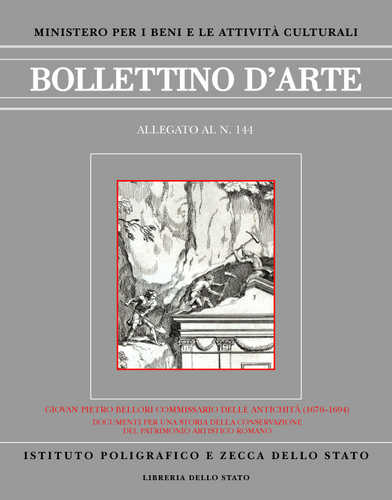GIOVAN PIETRO BELLORI COMMISSARIO DELLE ANTICHITÀ (1670-1694). Documenti per una storia della conservazione del patrimonio artistico romano (Allegato al n. 144, 2008)
|
||||
|

Allegato al fasc. 144
Questo volume allegato al fascicolo periodico n. 144 del Bollettino d’Arte esamina un importante segmento della storia della tutela del patrimonio artistico in Italia: la città di Roma nella seconda metà del sec. XVII, e le disposizioni riguardo agli scavi archeologici e all’esportazione di opere d’arte . Vengono esaminate quasi mille licenze rilasciate dallo Stato Pontificio a partire dal 1654, anno in cui iniziano i registri della Presidenza delle strade, principale fonte documentaria per tali licenze, fino al 1695, anno dell’ultima relazione su di uno scavo redatta da Giovan Pietro Bellori, pochi mesi prima della sua morte. Bellori, il celebre storico e teorico dell’arte, fu Commissario delle Antichità di Roma dal 1670 al 1694, dal pontificato di Clemente X Altieri a quello di Innocenzo XII Pignatelli, e il lungo periodo in cui fu responsabile di quell’incarico è particolarmente importante per la storia del controllo sul patrimonio artistico di Roma. Nel saggio che precede la pubblicazione di tutte le licenze, l’autore traccia brevemente la storia della carica del Commissario delle Antichità di Roma in particolare nel corso del Seicento, e contemporaneamente pone l’accento sulla difficoltà di applicare e fare rispettare una normativa sicuramente tra le più avanzate nella realtà storica di Roma: il vivacissimo mercato artistico, il desiderio sempre più diffuso ai più alti ranghi del collezionismo europeo di impossessarsi di testimonianze del passato classico della città, e la crescente debolezza dello Stato Pontificio nei confronti degli altri Stati sono spesso in conflitto con le istituzioni pubbliche romane e con il desiderio di mantenere alla città il suo straordinario patrimonio d’arte antica e moderna. Ne sono esempi eloquenti il trasporto delle più celebri antichità di Villa Medici nelle collezioni del Granduca di Toscana a Firenze, o le continue uscite di opere d’arte antica (ma anche di calchi e di opere moderne) verso Giovan Pietro Bellori, Commissioner for Antiquities (1670-1694). Documents for a history of the conservation of the artistic heritage in Rome This volume annexed to fascicule no. 144 of the Bollettino d’Arte examines an important aspect of the conservation of the artistic heritage in Italy: the city of Rome in the second half of the 17th century, and provisions regulating archaeological excavations and the export of works of art. The author examines almost a thousand licences issued by the Papal State between 1654, the year in which the registers of the Presidenza delle Strade, the main documentary sources for these licences, begin, and 1695, the year of the last excavation report written by Giovan Pietro Bellori, a few months before his death. Bellori, the famous historian and theoretician of art, was Commissioner for Antiquities of Rome from 1670 to 1694, from the pontificate of Clement X Altieri to that of Innocent XII Pignatelli, and the long period in which he held this post is particularly important for the history of the control of the artistic heritage in Rome.
In the introductory essay with which he prefaces the publication of all the licences in question, the author briefly traces the history of the post of Commissario delle Antichità di Roma, in particular during the seventeenth century. At the same time he places the emphasis on the difficulties of implementing, and enforcing compliance with, one of the most advanced laws of its kind in the history of Rome: the extremely thriving art market, the ever more widespread desire among leading European collectors to appropriate testimonies of the city’s classical past, and the growing weakness of the Papal State in its relations with other States, were often in conflict with the public institutions in Rome and with the desire to maintain the city’s control over its extraordinary heritage of ancient and modern art. Eloquent examples of the Papal State’s powerlessness to stem the haemorrhage of its patrimony include the transport of the most celebrated antiquities of the Villa Medici to the collections of the Grand–Duke of Tuscany in Florence, and the continuous exports of antiquities (and also plaster casts and modern works of art) to the France of Louis XIV. It was French failure to observe, or its deliberate flouting of the restrictions imposed by the pontifical authorities on the export of works of art that led to a clearer and more restrictive regulation, issued by the Cardinal Camerlengo Paluzzo Altieri with an edict on 5 February 1686. The author also examines the various types of licence: of the some thousand published here the majority consist of excavation permits, and only 65 regard modern works of art. Among these, in turn, only a very few paintings are subjected to controls (an indication of the extreme freedom of the market in this field). Controls on sculpture of the period, by contrast, are far more frequent. This is presumably linked to the fear that important antique sculptures could also be exported masquerading as modern works of art. Bellori tried to refuse the issuing of licences for the export of ancient sculptures if they were intact or of particular prestige, whereas export was easier in the case of heavily restored sculptures (i.e. those with substantial modern integrations). The volume ends with the publication of two documents that illustrate the conflicting interests of the time: the Altieri edict of 9 May 1685 that regulates excavations in the Papal State, and the memorandum sent by the Duc d’Estrées to Louis XIV in January 1687 to inform him of the fresh difficulties that had supervened in the export of works of art from Rome. |
||||






